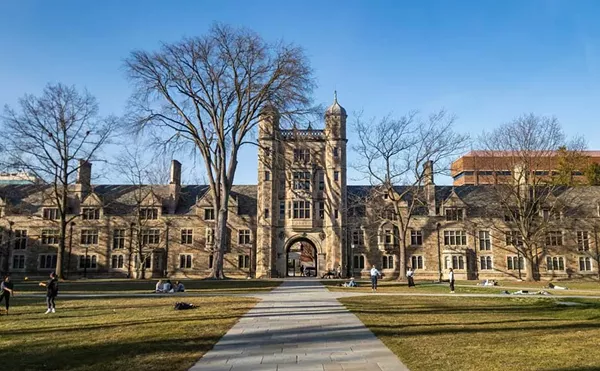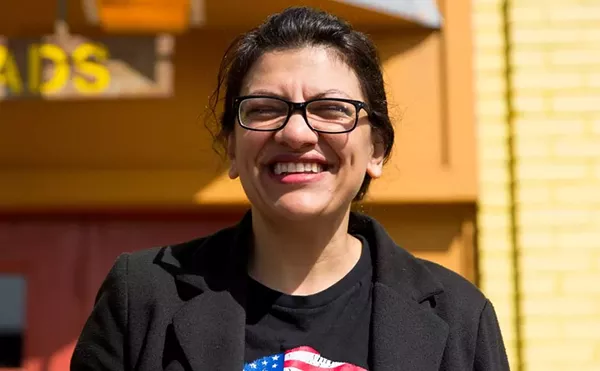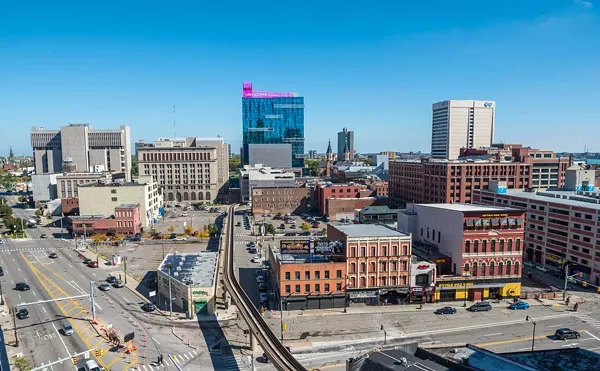SQUAWK THIS WAY
Detroit’s oft-neglected urban enclave of Third Avenue and West Willis saw renewed life last Saturday night, as the 1923-era former Weber Furniture Company showroom was reborn as The Furniture Factory, ground zero for the formerly Ann Arbor-based Walk & Squawk Performance Project.
In a nutshell, the Walk & Squawk crew produces performances and workshops employing physical and visual theater which, they claim, “defies categorization,” but is always “anchored in humor.”
While the style may defy categorization, the crowd at the party was pretty much standard-issue patrons-of-the-arts stuff, with a definite Ann Arbor tilt. I noticed one particular heavyset gent who sported a heavy black cableknit turtleneck, dark blazer and thick black glasses. It was if somebody called central casting and said “send us a pretentious, art-opening kind of guy.” The only thing missing was an ascot.
The requisite $175-per-head heavy-hitters (the “Movers,” in Walk & Squawk parlance) arrived for a 6 o’clock sit-down dinner and performance, while the nightlife denizens and professional freeloaders such as myself (the “Shakers,” but not the kind that make furniture) arrived after 8:30 for a strolling feast, cocktails and the sounds of British import DJ Hannah from Planet E Records.
Fortunately for this nonprofit group, they were able to enlist some philanthropic support from an array of well-known contributors, including Maggie and Bob Allesee, Bill and Betty Brooks and others. The Allesees are prominent supporters of the local arts scene, and are usually seen being dutifully trailed by that other “society” columnist from one of our dailies, however Mr. Margolin must have drawn Jennifer Nasser detail on Saturday night.
In any event, the space itself was cavernous and raw, yet still surprisingly cozy. The reception area includes a bar as well as a dual staircase which opens up to a large gallery area upstairs where the paintings of Lenore Gimpert were prominently displayed.
The front of the building was where the sit-down dinner took place, cordoned off by some draped fabric to keep out the riff and raff, whereas the back of the building contains the actual theater space.
According to co-Artistic Directors Hilary Ramsden and Erika Block, the front portion of the building will eventually be rented out for retail or possibly a restaurant, while the upstairs will be available as office space.
Among those swaying and twirling to the sounds of the after-party were Wolanda Lewis and the unabbreviated Michelle Gloris Alfonso-Perez Elias. I also spotted dapper Gold Dollar impresario Neil Yee mingling at the mixer, but he headed back to the Gold Dollar to check in on the White Stripes, who were playing their second jam-packed Gold Dollar gig in as many tobacco-infused hipster-heavy nights.
The Walk & Squawk group will be performing Something Wicked This Way Comes through Nov. 5. In addition, starting in November, there will be Saturday night after-parties (“the Squawk Sessions”) with live music, DJs and assorted other pleasantries. All in all, an undeniably welcome addition to the neighborhood as well as the city.
CALLING PROFESSOR PLUM
Those of you who were around Detroit in 1966 may recall the short-lived boho enclave launched on the Fourth of July and known as Plum Street. This planned hippie neighborhood sought to emulate Chicago’s Old Town and St. Louis’ Gas Light Square, and was located between Fourth and Fifth on Plum Street, where the Edison Plaza parking lots are currently located.
Invoking the at-the-time popular yet now-inexplicable gaslit Gay ’90s theme (remember Lum’s?), the end result was sort of a Farrell’s-meets-head shoppe with a soupçon of Renaissance Fest, as assorted soap and candle makers plied their trades, coffeehouses sold their brew, and the pungent aromas of incense and cannabis permeated the air.
At its peak, there were more than 43 shops, but it pretty much flamed out a few years later, as bikers took over the parking lots and many of the hippies followed John Sinclair to Ann Arbor.
The erstwhile emperor of Plum Street was one Robert Cobb, then 24 years old, and more recently the former Cobb’s Corner/Willis Gallery proprietor. Cobb has resurfaced as of late, acquiring some sizable buildings on Woodward including the CPop gallery building as well as some neighboring structures.
Could it be that the follicle-challenged, toupee-clad, diminutive Cobb is planning a reborn Plum Street on Woodward in the Drunken Village? Is the Gay ’90s theme making a comeback? Stay tuned for the answer to these and many other pressing issues. I’d better trim my handlebar moustache and get my red-and-white striped suit pressed, just to be safe.
Speaking of CPop, there will be a party this Saturday beginning at 7 sharp to celebrate the well-nigh Hallow’s Eve epilogue of Niagara’s show. On hand will be live bats, that’s right, bats, courtesy of Rob Mies and Kim Williams of the Organization of Bat Conservation. The Bat Lounge on Brush Street is not a sponsor.
IT’S A GREAT TIME IN DETROIT’S RUINS!
Obviously, the much-maligned Detroit tourism slogan is taking root, as Travel and Leisure magazine is planning a spread on Detroit for its November issue. While at a wedding in Washington, D.C., last week, I met an individual who assisted on the photo shoot.
No doubt much to the chagrin of the mayor and the tourism bureau, however, the piece will focus on Detroit’s famed ruins, e.g. Brush Park (not the condos), the Book Cadillac, the Statler Hotel, the Michigan Central Train Station et al.
Taking their cue from photographer/sociologist Camilo José Vergara (American Ruins), who previously suggested that Detroit cordon off much of the downtown as a “skyscraper’s graveyard,” the Travel and Leisure crew wandered about the town with local urban spelunkers, marveling at our own modern-day Acropolis-in-progress.
While it’s doubtful the city will print up any glossy brochures to trumpet such attractions, it’s clear that the ruins have replaced Devil’s Night as one of Detroit’s bigger schadenfreude-style international tourist draws.
Casey Coston writes about development in Detroit. E-mail him at [email protected]





